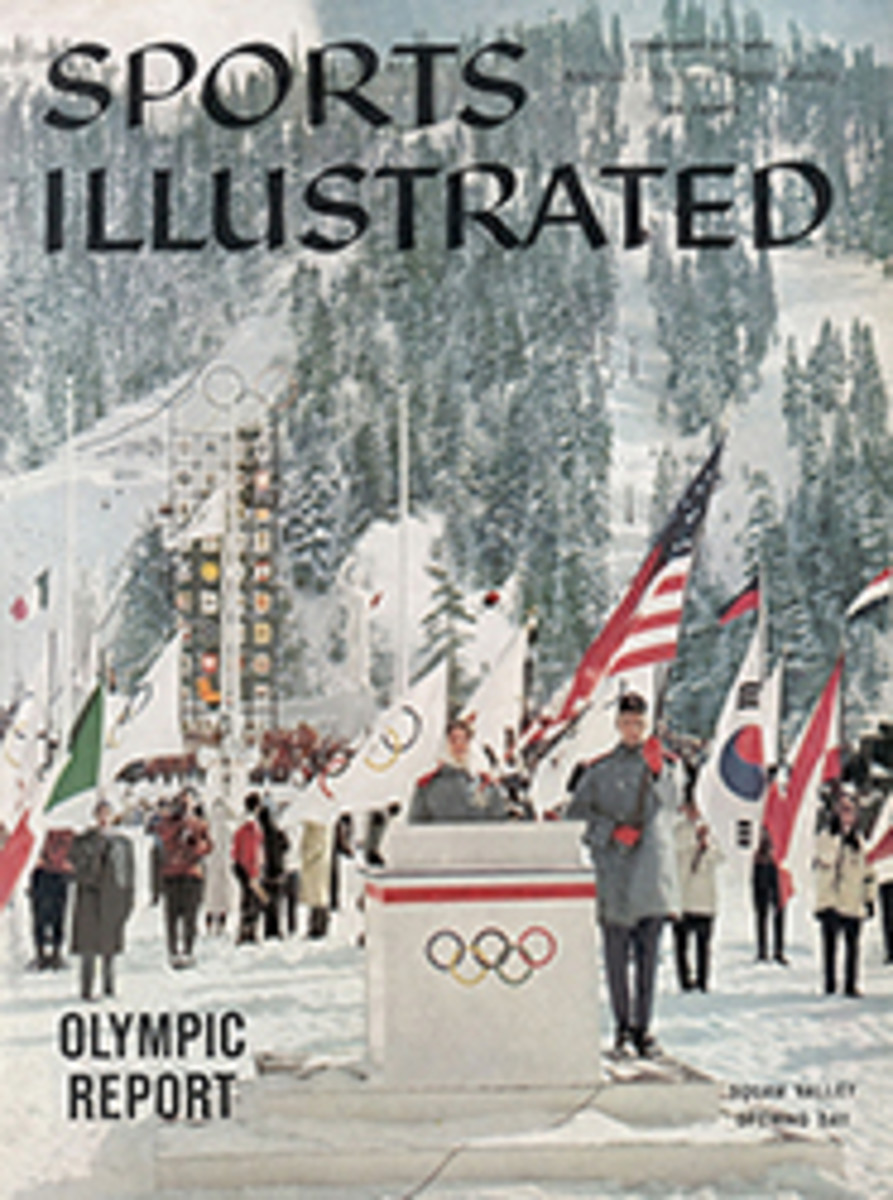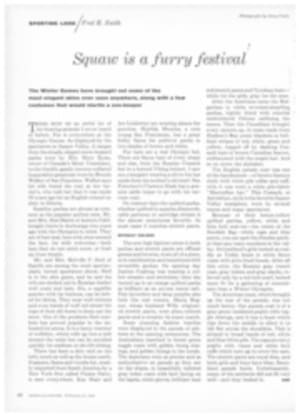
Squaw is a furry festival
There must be an awful lot of fur-bearing animals I never heard of before. Fur is everywhere at the Olympic Games. As displayed by the spectators at Squaw Valley, it ranges from the simple, elegant snow-leopard parka worn by Mrs. Mary Ryan, owner of Canada's Mont Tremblant, to the frankly gaudy raccoon-collared leopardskin greatcoat worn by Brooks Walker of San Francisco. Walker says his wife found the coat at her furrier's, who told her that it was made 30 years ago for an English colonel on duty in Siberia.
Sealskin parkas are almost as common as the popular quilted ones. Mr. and Mrs. Hud Hatch of Auburn Calif. bought theirs in Anchorage two years ago with the Olympics in mind. They are of hair seal, hers with otter around the face, his with wolverine—both furs that do not catch snow, or frost up from breath.
Mr. and Mrs. Melville P. Steil of Seattle are among the most spectacularly furred spectators about. Steil is in the skin game, and he and his wife are decked out in Russian timber wolf coats and hats. His, a capelike poncho with fur buttons, can be belted for skiing. They wear wolf mittens and even bands of wolf tail about the tops of their ski boots to keep out the snow. One of the products Steil markets has proved popular in the unheated ice arena. It is a fanny-warmer of wolfskin, which rolls up into a belt around the waist but can be unrolled quickly for stadium or ski-lift sitting.
There has been a skin raid on the lofty south as well as the frozen north. Guanaco, llama and vicuña fur, mostly imported from South America by a New York firm called Pinata Party, is seen everywhere. Kay Starr and Art Linkletter are wearing alpaca fur ponchos. Matilda Menzies, a cute young San Franciscan, has a great bulky llama fur pullover parka in two shades of brown and white.
Fur hats are a real Olympic fad. There are llama hats of every shape and size, from the Russian Cossack hat to a horned Viking helmet. I saw one youngster wearing a silver fox hat made from his mother's old scarf. San Francisco's Clarence Slade has a genuine sable toque to go with his raccoon coat.
On warmer days the quilted parka, whether quilted in squares, diamonds, cable patterns or cartridge stripes is the almost unanimous favorite. In most cases it matches stretch pants.
OFFBEAT COLORS
The new high fashion colors in both parkas and stretch pants are offbeat greens and browns, worn all of a piece, or in combination and sometimes with reversible parkas. On opening day Justine Cushing was wearing a yellow sweater and stretchies; later she turned up in an orange quilted parka as brilliant as an air-sea rescue raft. Pale lavenders and deep purples also look like real comers. Maria Bogner, whose husband Willy originated stretch pants, wore plum-colored pants and a sweater its exact match.
Some stunning fashion touches were displayed in the parade of athletes at the opening ceremonies. The Australians marched in forest green toggle coats with golden thong closings, and golden linings in the hoods. The Austrians were as precise and as authoritative on parade as they are on the slopes, in beautifully tailored gray loden coats with knit facing on the lapels, white gloves, brilliant taut red stretch pants and Tyrolean hats—white for the girls, gray for the men.
After the Austrians came the Bulgarians in white reversed-shearling parkas, tightly fitted with colorful embroidered ribbons outlining the seams. Then the Canadians brought every camera up, in coats made from Hudson's Bay point blankets in brilliant stripes of red, white, green and yellow, topped off by dashing Cossack hats of brown Canadian beaver, emblazoned with the maple leaf. And so on down the alphabet.
The English parade coat was one of the handsomest—of brown Gannex cloth with white pile collar and cuff; with it was worn a white pile-fabric "Macmillan hat." This Cossack, or Astrakhan, style is the favorite Squaw Valley headpiece, worn by several teams and many spectators.
Because of their lemon-yellow quilted parkas, yellow, white and blue knit scarves—the colors of the Swedish flag—white caps and blue pants, you can spot the Swedes quicker than any team members in the valley. Switzerland's girls looked as cuddly as Teddy bears in white fleece coats with pink-lined hoods. After all this color, the Russian gray trench coat, gray fedora and gray slacks, relieved only by a red knit scarf, looked more fit for a gathering of commissars than a Winter Olympics.
The American team, which brought up the rear of the parade, was not much better. Our parade coat is of a gray-green insulated poplin with toggle closings, and it has a hood which zips down the middle to allow it to fall flat across the shoulders. This is striped in broad bands of red, white and blue Orion pile. The caps are navy poplin with visors and white knit cuffs which turn up to cover the ears. The stretch pants are royal blue, and both girls and boys have blue, fleece-lined parade boots. Unfortunately, many of the uniforms did not fit very well—and they looked it.
PHOTO
JERRY COOKE
SEALSKIN PARKA with a fake polar bear hat is worn by Chicago's Tony Ryerson.
PHOTO
JERRY COOKE
TANGIER "BURNOOSE" made of unwashed wool is worn as coat by Walter McQuesten.
PHOTO
JERRY COOKE
ALPACA TUNIC is worn by Actress Elaine Stewart, and even her pug has a sweater.
PHOTO
JERRY COOKE
LAPLAND COSTUME adorns Albert Martilla, a Finn who now lives in Berkeley.
PHOTO
JERRY COOKE
WOLF SUITS provide warm and exotic coverings for Mr. and Mrs. Melville Steil of Seattle.
PHOTO
JERRY COOKE
PULLOVER PONCHO lined with alpaca fur calls attention to Singer Kay Starr.
PHOTO
JERRY COOKE
LEOPARD GREATCOAT on San Francisco's Brooks Walker was made for use in Siberia.
PHOTO
JERRY COOKE
A SABLE HAT is combined with a raccoon coat by Clarence Slade of San Francisco.
PHOTO
JERRY COOKE
SNOW-LEOPARD coat on Mary Ryan of Mont Tremblant was most elegant fur.

